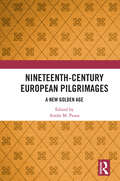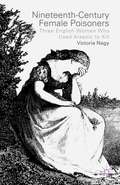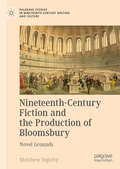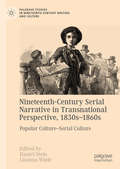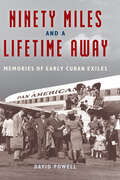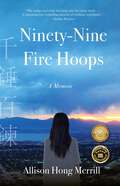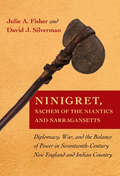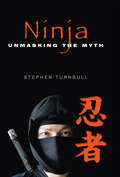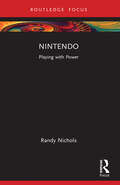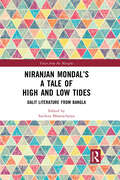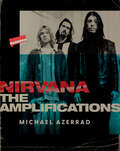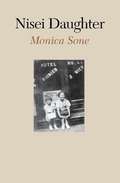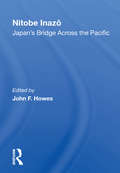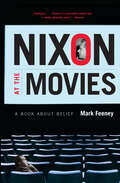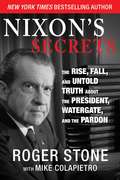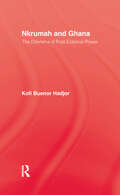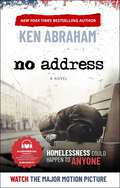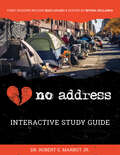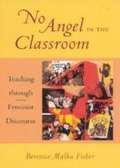- Table View
- List View
Nineteenth-Century European Pilgrimages: A New Golden Age
by Antón M. PazosDuring the Nineteenth-Century a major revival in religious pilgrimage took place across Europe. This phenomenon was largely started by the rediscovery of several holy burial places such as Assisi, Milano, Venice, Rome and Santiago de Compostela, and subsequently developed into the formation of new holy sites that could be visited and interacted with in a wholly Modern way. This uniquely wide-ranging collection sets out the historic context of the formation of contemporary European pilgrimage in order to better understand its role in religious expression today. Looking at both Western Catholic and Eastern Orthodox Europe, an international panel of contributors analyse the revival of some major Christian shrines, cults and pilgrimages that happened after the rediscovery of ancient holy burial sites or the constitution of new shrines in locations claiming apparitions of the Virgin Mary. They also shed new light on the origin and development of new sanctuaries and pilgrimages in France and the Holy Land during the Nineteenth Century, which led to fresh ways of understanding the pilgrimage experience and had a profound effect on religion across Europe. This collection offers a renewed overview of the development of Modern European pilgrimage that used intensively the new techniques of organisation and travel implemented in the Nineteenth-Century. As such, it will appeal to scholars of Religious Studies, Pilgrimage and Religious History as well as Anthropology, Art, Cultural Studies, and Sociology.
Nineteenth-Century Female Poisoners
by Victoria M. NagyNineteenth-Century Female Poisoners investigates the Essex poisoning trials of 1846 to 1851 where three women were charged with using arsenic to kill children, their husbands and brothers. Using newspapers, archival sources (including petitions and witness depositions), and records from parliamentary debates, the focus is not on whether the women were guilty or innocent, but rather on what English society during this period made of their trials and what stereotypes and stock-stories were used to describe women who used arsenic to kill. All three women were initially presented as 'bad' women but as the book illustrates there was no clear consensus on what exactly constituted bad womanhood. "
Nineteenth-Century Female Poisoners: Three English Women Who Used Arsenic to Kill
by V. NagyNineteenth-Century Female Poisoners investigates the Essex poisoning trials of 1846 to 1851 where three women were charged with using arsenic to kill children, their husbands and brothers. Using newspapers, archival sources (including petitions and witness depositions), and records from parliamentary debates, the focus is not on whether the women were guilty or innocent, but rather on what English society during this period made of their trials and what stereotypes and stock-stories were used to describe women who used arsenic to kill. All three women were initially presented as 'bad' women but as the book illustrates there was no clear consensus on what exactly constituted bad womanhood.
Nineteenth-Century Fiction and the Production of Bloomsbury: Novel Grounds (Palgrave Studies In Nineteenth-century Writing And Culture )
by Matthew InglebyThis study explores the role of fiction in the social production of the West Central district of London in the nineteenth century. It tells a new history of the novel from a local geographical perspective, tracing developments in the form as it engaged with Bloomsbury in the period it emerged as the city’s dominant literary zone. A neighbourhood that was subject simultaneously to socio-economic decline and cultural ascent, fiction set in Bloomsbury is shown to have reconceived the area’s marginality as potential autonomy. Drawing on sociological theory, this book critically historicizes Bloomsbury’s trajectory to show that its association with the intellectual “fraction” known as the ‘Bloomsbury Group’ at the beginning of the twentieth century was symptomatic rather than exceptional. From the 1820s onwards, writers positioned themselves socially within the metropolitan geography they projected through their fiction. As Bloomsbury became increasingly identified with the cultural capital of writers rather than the economic capital of established wealth, writers subtly affiliated themselves with the area, and the figure of the writer and Bloomsbury became symbolically conflated.
Nineteenth-Century Serial Narrative in Transnational Perspective, 1830s−1860s: Popular Culture—Serial Culture (Palgrave Studies in Nineteenth-Century Writing and Culture)
by Daniel Stein Lisanna WieleThis volume examines the emergence of modern popular culture between the 1830s and the 1860s, when popular storytelling meant serial storytelling and when new printing techniques and an expanding infrastructure brought serial entertainment to the masses. Analyzing fiction and non-fiction narratives from the United States, France, Great Britain, Germany, Austria, Turkey, and Brazil, Popular Culture—Serial Culture offers a transnational perspective on border-crossing serial genres from the roman feuilleton and the city mystery novel to abolitionist gift books and world’s fairs.
Nineteenth-Century Spanish America: A Cultural History
by Christopher ConwayNineteenth-Century Spanish America: A Cultural History provides a panoramic and accessible introduction to the era in which Latin America took its first steps into the Modern Age. Including colorful characters like circus clowns, prostitutes, bullfighters, street puppeteers, and bestselling authors, this book maps vivid and often surprising combinations of the new and the old, the high and the low, and the political and the cultural. Christopher Conway shows that beneath the diversity of the New World there was a deeper structure of shared patterns of cultural creation and meaning. Whether it be the ways that people of refinement from different countries used the same rules of etiquette, or how commoners shared their stories through the same types of songs, Conway creates a multidisciplinary framework for understanding the culture of an entire hemisphere. The book opens with key themes that will help students and scholars understand the century, such as the civilization and barbarism binary, urbanism, the divide between conservatives and liberals, and transculturation. In the chapters that follow, Conway weaves transnational trends together with brief case studies and compelling snapshots that help us understand the period. How much did books and photographs cost in the nineteenth century? What was the dominant style in painting? What kinds of ballroom dancing were popular? Richly illustrated with striking photographs and lithographs, this is a book that invites the reader to rediscover a past age that is not quite past, still resonating into the present.
Nineteenth-Century Spanish America: A Cultural History
by Christopher ConwayNineteenth-Century Spanish America: A Cultural History provides a panoramic and accessible introduction to the era in which Latin America took its first steps into the Modern Age. Including colorful characters like circus clowns, prostitutes, bullfighters, street puppeteers, and bestselling authors, this book maps vivid and often surprising combinations of the new and the old, the high and the low, and the political and the cultural. Christopher Conway shows that beneath the diversity of the New World there was a deeper structure of shared patterns of cultural creation and meaning. Whether it be the ways that people of refinement from different countries used the same rules of etiquette, or how commoners shared their stories through the same types of songs, Conway creates a multidisciplinary framework for understanding the culture of an entire hemisphere. The book opens with key themes that will help students and scholars understand the century, such as the civilization and barbarism binary, urbanism, the divide between conservatives and liberals, and transculturation. In the chapters that follow, Conway weaves transnational trends together with brief case studies and compelling snapshots that help us understand the period. How much did books and photographs cost in the nineteenth century? What was the dominant style in painting? What kinds of ballroom dancing were popular? Richly illustrated with striking photographs and lithographs, this is a book that invites the reader to rediscover a past age that is not quite past, still resonating into the present.
Ninety Miles and a Lifetime Away: Memories of Early Cuban Exiles
by David PowellRare accounts of Cuban migration in the words of the exiles themselvesBringing together an unprecedented number of extensive personal stories, this book shares the triumphs and heartbreaking moments experienced by some of the first Cubans to come to the United States after Fidel Castro took power in 1959. Ninety Miles and a Lifetime Away is a moving look inside fifteen years of migration that changed the two countries and transformed the lives of the people who found themselves separated from their homeland.David Powell presents interviews with refugees who left Cuba between 1959 and the 1962 Missile Crisis, as well as those who embarked on the Freedom Flights of the late 1960s and early 1970s. During these years more than 600,000 Cubans migrated to the US, some by way of other countries and many arriving in Miami with only a few clothes and pocket money. In their own words, exiles describe why they left the island, how they prepared for departure, what situations they faced when they arrived in the US, and how they integrated into American life.Offering historical background that illuminates this pivotal period in the context of the Cold War, Powell shows how the US government’s Cuban refugee assistance program had far-reaching effects on refugee policy, bilingual education, and child welfare programs. The testimonies in this book include new information about low-cost “Cuban Loans” that enabled young exiles to attend US colleges, preparing many to be builders and leaders in their adopted country today.A powerful portrayal of the initial effects of a revolution that began a new era in Cuba’s relationship with the world, this book preserves rare accounts of the motivations and struggles of early Cuban exiles in the words of the emigres themselves, adding gripping detail to the history of the modern Cuban diaspora.Publication of this work made possible by a Sustaining the Humanities through the American Rescue Plan grant from the National Endowment for the Humanities.
Ninety-Nine Fire Hoops: A Memoir
by Allison Hong MerrillAllison Hong is not your typical fifteen-year-old Taiwanese girl. Unwilling to bend to the conditioning of her Chinese culture, which demands that women submit to men&’s will, she disobeys her father&’s demand to stay in their faith tradition, Buddhism, and instead joins the Church of Jesus Christ of Latter-day Saints. Then, six years later, she drops out of college to serve a mission—a decision for which her father disowns her.After serving her mission in Taiwan, twenty-two-year-old Allison marries her Chinese-speaking American boyfriend, Cameron Chastain. But sixteen months later, Allison returns home to their Texas apartment and is shocked to discover that, in her two-hour absence, Cameron has taken all the money, moved out, and filed for divorce. Desperate for love and acceptance, Allison moves to Utah and enlists in an imaginary, unforgiving dating war against the bachelorettes at Brigham Young University, where the rules don&’t make sense—and winning isn&’t what she thought it would be.
Ninigret, Sachem of the Niantics and Narrangansetts: Diplomacy, War, and the Balance of Power in Seventeenth-Century New England and Indian Country
by Julie A. Fisher David J. SilvermanNinigret was a sachem of the Niantic and Narragansett Indians of what is now Rhode Island from the mid-1630s through the mid-1670s. For Ninigret and his contemporaries, Indian Country and New England were multipolar political worlds shaped by ever-shifting intertribal rivalries. In the first biography of Ninigret, Julie A. Fisher and David J. Silverman assert that he was the most influential Indian leader of his era in southern New England. As such, he was a key to the balance of power in both Indian-colonial and intertribal relations.Ninigret was at the center of almost every major development involving southern New England Indians between the Pequot War of 1636-37 and King Philip's War of 1675-76. He led the Narrangansetts' campaign to become the region's major power, including a decades-long war against the Mohegans led by Uncas, Ninigret's archrival. To offset growing English power, Ninigret formed long-distance alliances with the powerful Mohawks of the Iroquois League and the Pocumtucks of the Connecticut River Valley. Over the course of Ningret's life, English officials repeatedly charged him with plotting to organize a coalition of tribes and even the Dutch to roll back English settlement. Ironically, though, he refused to take up arms against the English in King Philip's War. Ninigret died at the end of the war, having guided his people through one of the most tumultuous chapters of the colonial era.
Ninja: Unmasking the Myth
by Stephen TurnbullThis history of the ninja uncovers the truth behind the image—from the exploits of medieval ninjas to their modern incarnation as pop culture icons. The ninja is a legendary figure in Japanese military culture, a fighter widely regarded as the world&’s greatest expert in secret warfare. The word alone conjures the image of a masked assassin dressed in black, capable of extraordinary feats of daring; a mercenary who disposes of enemies by sending sharp iron stars spinning towards them. This is, of course, a popular myth, based on exaggerations and Hollywood movies. But the truth, as Stephen Turnbull explains in Ninja, is even more fascinating. A leading expert on samurai culture, Turnbull presents an authoritative study of ninja history based on original Japanese sources, many of which have never been translated before. These include accounts of castle attacks, assassinations and espionage, as well as the last great ninja manual, which reveals the spiritual and religious ideals that were believed to lie behind the ninja&’s arts. Turnbull&’s critical examination of the ninja phenomenon ranges from undercover operations during the age of Japan&’s civil wars to the modern emergence of the superman ninja as a comic book character. The book concludes with a detailed investigation of the ninja in popular culture.
Nintendo: Playing with Power (Global Media Giants)
by Randy NicholsOriginally founded in 1889 as a manufacturer of playing cards, this book examines the history and political economic status of the multinational consumer electronics and video game giant Nintendo. This book offers a deeper examination into Nintendo as a global media giant, with some of the industry’s best-selling consoles and most recognizable intellectual property including Mario, Pokémon, and Zelda. Drawing upon the theory of the political economy of communication, which seeks to understand how communication and media serve as key mechanisms of economic and political power, Randy Nichols examines how Nintendo has maintained its dominance in the global video game industry and how it has used its position to shape that industry. This book argues that while the company’s key figures and main franchises are important, Nintendo’s impact as a company – and what we can learn from its evolution – is instructive beyond the video game industry. This book is perfect for students and scholars of media and cultural industries, critical political economy of media, production studies, and games studies.
Ninth Art. Bande dessinée, Books and the Gentrification of Mass Culture, 1964-1975 (Palgrave Studies in Comics and Graphic Novels)
by Sylvain LesageIn France, comics are commonly referred to as the "ninth art". What does it mean to see comics as art? This book looks at the singular status of comics in the French cultural landscape. Bandes dessinées have long been published in French newspapers and magazines. In the early 1960s, a new standard format emerged: large hardback books, called albums. Albums played a key role in the emergence of the ninth art and its acceptance among other forms of literary narrative. From Barbarella in 1964 to La Ballade de la mer salée in 1975, from Astérix and its million copies to Tintin and its screen versions, within the space of just a few years the comics landscape underwent a deep transformation.The album opened up new ways of creating, distributing, and reading bandes dessinées. This shift upended the market, transformed readership, initiated new transmedia adaptations, generated critical discourse, and gave birth to new kinds of comics fandom. These transformations are analysed through a series of case studies, each focusing on a noteworthy album. By retracing the publishing and critical history of these classic bandes dessinées, this book questions the blind spots of a canon based on the album format and uncovers the legitimisation processes that turned bande dessinée into the ninth art.
Niranjan Mondal’s A Tale of High and Low Tides: Dalit Literature from Bangla (Voices from the Margins)
by Sucheta BhattacharyaNiranjan Mondal is one of the most prolific writers of Dalit literature in Bangla known for his immersive fictions that root themselves in the lives of people from the Sundarbans, the mangrove forest in east India. This volume of the translation of his novel, A Tale of High and Low Tides (Ujaan Bhatir Kathokata), along with critical essays and an interview of the author, introduces his work to a new readership.Mondal’s writings highlight the unique lived experiences of the inhabitants of the Sundarbans and are meditative explorations of the links between caste and expression, nature and human life, and the ‘centre’ and the ‘margin’. This book creates a dialogue between the body of literature that is visible and that which is not, as well as between biography and literature. Mondal’s own views on contemporary life, society, and literature—both mainstream and marginalized—will help readers understand the relationship between literature and its social context. The volume creates an academic framework within which Mondal’s fiction can be read, appreciated and critically analysed. Part of the Voices from the Margins series, this critical edition will be an important resource for students of literature, comparative literature, modern Indian literature, translation studies, minority studies, Dalit studies, and gender studies. It will also be of interest to those engaged in contemporary Indian/South Asian literary cultures, social sciences, history and sociology.
Nirvana: The Amplifications
by Michael AzerradMichael Azerrad reflects on the meaning of the revolutionary band, Nirvana, his friendship with Kurt Cobain, and the impact of the '90s thirty years later. Includes 20 images of posters and ephemera from the time. Note: This is the compilation of the essay-like annotations from THE AMPLIFIED COME AS YOU ARE: The Story of Nirvana, excluding the underlying 1993 book.
Nisei Daughter
by Monica Itoi SoneMonica Sone grew up struggling with her identity in a part-American, part-Japanese world. Her memoir describes pre-war Seattle and the conflict she experienced between her two sides.
Nisei: The Quiet Americans
by Bill HosokawaThis book describes the discrimination and struggles faced by the Japanese in America at the internment camps during the Second World War.
Nitinikiau Innusi: I Keep the Land Alive (Contemporary Studies on the North #7)
by Tshaukuesh Elizabeth PenashueLabrador Innu cultural and environmental activist Tshaukuesh Elizabeth Penashue is well-known both within and far beyond the Innu Nation. The recipient of a National Aboriginal Achievement Award and an honorary doctorate from Memorial University, she has been a subject of documentary films, books, and numerous articles. She led the Innu campaign against NATO’s low-level flying and bomb testing on Innu land during the 1980s and ’90s, and was a key respondent in a landmark legal case in which the judge held that the Innu had the “colour of right” to occupy the Canadian Forces base in Goose Bay, Labrador. Over the past twenty years she has led walks and canoe trips in nutshimit, “on the land,” to teach people about Innu culture and knowledge. Nitinikiau Innusi: I Keep the Land Alive began as a diary written in Innu-aimun, in which Tshaukuesh recorded day-to-day experiences, court appearances, and interviews with reporters. Tshaukuesh has always had a strong sense of the importance of documenting what was happening to the Innu and their land. She also found keeping a diary therapeutic, and her writing evolved from brief notes into a detailed account of her own life and reflections on Innu land, culture, politics, and history. Beautifully illustrated, this work contains numerous images by professional photographers and journalists as well as archival photographs and others from Tshaukuesh’s own collection.
Nitobe Inazo: Japan's Bridge Across The Pacific
by John F HowesA collection of essays which chronicles the career and works of Japan's self-proclaimed bridge across the Pacific, Nitobe Inazo. He was appointed Under-Secretary of the League of Nations before the Japanese invasion of Manchuria in 1931 led to his downfall.
Nixon at the Movies: A Book about Belief
by Mark Feeney&“People will be arguing over Nixon at the Movies as much as, for more than half a century, the country at large has been arguing about Nixon.&”—Greil Marcus Richard Nixon and the film industry arrived in Southern California in the same year, 1913, and they shared a long and complex history. The president screened Patton multiple times before and during the invasion of Cambodia, for example. In this unique blend of political biography, cultural history, and film criticism, Mark Feeney recounts in detail Nixon&’s enthusiastic viewing habits during his presidency, and takes a new and often revelatory approach to Nixon&’s career and Hollywood&’s, seeing aspects of Nixon&’s character, and the nation&’s, refracted and reimagined in film. Nixon at the Movies is a &“virtuosic&” examination of a man, a culture, and a country in a time of tumult (Slate). &“By Feeney's count, Nixon, an unabashed film buff, watched more than 500 movies during the 67 months of his presidency, all carefully listed in an appendix titled &‘What the President Saw and When He Saw It.&’ Nixon concentrated intently on whatever was on the screen; he refused to leave even if the picture was a dud and everyone around him was restless. He was omnivorous, would watch anything, though he did have his preferences…Only rarely did he watch R-rated or foreign films. He liked happy endings. Movies were obviously a means of escape for him, and as the Watergate noose tightened, he spent ever more time in the screening room.&”—The New York Times
Nixon's Secrets: The Rise, Fall, and Untold Truth about the President, Watergate, and the Pardon
by Mike Colapietro Roger Stone"We appreciate Roger Stone, he is one tough cookie." - President TrumpLearn the inside scoop on Watergate, the Ford Pardon, and the 18 ½ minute Gap.Roger Stone, The New York Times bestselling author of The Man Who Killed Kennedy-the Case Against LBJ, gives the inside scoop on Nixon’s rise and fall in Watergate in his new book Nixon’s Secrets. Stone charts Nixon’s rise from election to Congress in 1946 to the White House in 1968 after his razor-thin loss to John Kennedy in 1960, his disastrous campaign for Governor of California in 1962 and the greatest comeback in American Presidential history."Just as the assassination of JFK prevents a balanced analysis of Kennedy and his times, the myth of Watergate prevents a reappraisal of our 37th President.” said Stone who’s book on LBJ was the second biggest selling book during the 50th anniversary of Kennedy’s murder.Stone reveals how the Kennedy’s wiretapped Nixon’s hotel room the night before the Nixon-Kennedy debate, and stole Nixon's medical records from his psychiatrist’s office. Stone lays out how Kennedy running mate Lyndon Johnson stole Texas from JFK through vote fraud while Mayor Richard Daley stole Illinois, and how JFK actually lost the popular vote. Stone looks at the Nixon Presidency: the desegregation of the public schools, the progressive social programs, Nixon's struggle to end the war in Vietnam, the historic SALT arms reduction agreement with Russia, the saving of Israel in the Six Days War, the opening to China, and the disastrous decision to take America off the Gold standard."The mainstream media’s interpretation of the facts surrounding the Watergate episode are a fantastic and grotesque distortion of historical truth,” said Stone. "Cursory examination of the facts in Watergate will reveal that the actions which caused the fall of Nixon cannot be reduced to the simplistic account summarized by Bob Woodward and Carl Bernstein of the Washington Post.”The author outlines how White House Counsel John Dean, planned, pushed and covered-up the Watergate break-in , then sought to avoid responsibility for it. Stone examines the bungled Watergate break-in to determine what exactly Nixon’s agents were looking for and how the CIA infiltrated the burglar team and sabotaged the break-in to gain leverage over Nixon. Find out why Nixon demanded the CIA turn over the records of the Bay of Pigs and Kennedy Assassination.Learn how a cabal of military and intelligence hard-liners spied on andundermined Nixon to stop his pro-peace détente foreign policy, his withdrawal of troops from Vietnam, his arms limitation agreement with the Soviets, and his opening to Red China. Discover how Vice President Spiro Agnew was setup to move him out of the line of presidential succession. Stone makes the compelling case that General Alexander Haig orchestrated Nixon’s removal from office in a coup d’état and brokered the deal for his pardon. Finally the public will learn what is on the 18 ½ minute gap in the White House Tapes.Stone, a Washington Insider for forty years, outlines why FBI Man Mark Felt is not deep throat, why there is no deep throat, and why Bob Woodward and Carl Bernstein lie about it even today.Stone reveals how Nixon used the dark secrets he knew to avoid prosecution by blackmailing Gerald Ford for a full, free and unconditional pardon. Nixon’s secret would not only destroy his presidency-it would save him from prison and allow him to launch his final comeback-advising President Bill Clinton on Foreign Affairs despite Hillary’s attempts to block him and her being fired from the 1974 House Impeachment Committee for lying and violating Nixon’s rights.Skyhorse Publishing, as well as our Arcade imprint, are proud to publish a broad range of books for readers interested in history--books about World War II, the Third Reich, Hitler and his henchmen, the JFK assassination, conspiracies, the American Civil War, the American Revolution, gladiators, Vikings, ancient Rome, medieval times, the old West, and much more. While not every title we publish becomes a New York Times bestsell...
Nkrumah & Ghana
by HadjorFirst published in 1989. Routledge is an imprint of Taylor & Francis, an informa company.
No Address: A Novel
by Ken AbrahamBased on the critically acclaimed dramatic film and inspired by true events, No Address shows how homelessness can happen to anyone.No Address is a gripping tale about a group of individuals who find themselves homeless due to unfortunate circumstances. It provides a realistic portrayal of their fight for survival against the gangs, vigilantes, and an uncompassionate community. The first character we meet is Lauren, a recent high school graduate who returns to her foster home only to find herself locked out. Having been in foster care since her mother passed away unexpectedly when she was eight, Lauren has no family or true friends to rely on. With no place to stay, she finds herself on the street and vulnerable. We also meet Jimmy, who left home at the young age of sixteen to escape his father&’s abuse only to find himself now spiraling down into a world of homelessness. A kindhearted homeless veteran finds him sleeping on a bench and takes him under his wing, introducing him to his street family, mentally ill Dora … drug user Violet … and now a runaway Jimmy. Finally, we have Robert, a successful real estate broker who struggles as an addictive gambler. This problem has put his job, his family, and his whole livelihood in jeopardy. Will Robert travel down the road of homelessness? As these individuals navigate the challenges of daily life in unimaginable circumstances, they encounter life-threatening challenges that never seem to end. Despite every obstacle, they find strength and resilience to overcome these hardships through their unbreakable bond and true friendship. No Address is a story of the endurance of the human spirit, offering hope for a better tomorrow.
No Address: An Interactive Study Guide
by Dr. Robert G. Marbut Jr.A four-session interactive Bible study, based on the documentary Americans with No Address, that examines the biblical response to people experiencing homelessness. Homelessness is not an &“issue&”; it&’s an opportunity for the church to love our neighbors. In this four-session interactive Bible study, we examine what Scripture has to say on the topic. A companion to the documentary Americans with No Address and the full-length theatrical movie No Address (starring Ashanti, William Baldwin, Beverly D&’Angelo, and Xander Berkeley), this study teaches participants: The root causes of different types of homelessness. How to engage rather than enable. The importance of collaboration among existing agencies. How to mobilize their church to follow Jesus&’ call to serve. Each session includes: Facts, true stories, and background about the people who experience homelessness in America. QR code for quick link to online videos. Discussion questions for churches and small groups. Perspective from the Bible. &“Go and Do&” action steps. Ideas for further resources. Prayer prompts and reflection questions. The government can&’t solve homelessness alone. The nonprofit sector can&’t solve it alone. But neighbors loving neighbors, working together, can make a difference for the people who are experiencing homelessness in America. No Address equips Christians to lead the way.
No Angel in the Classroom: Teaching Through Feminist Discourse
by Berenice Malka FisherNo Angel in the Classroom: Teaching through Feminist Discourse presents a theoretically complex yet down-to-earth and personal account of feminist teaching in higher education. Starting with a nuanced interpretation of consciousness-raising, longtime feminist educator Berenice Malka Fisher develops her philosophy of feminist teaching as a form of political discourse. Through reflection on a series of candid classroom stories, she analyzes knotty problems faced by academics and activists. What counts as knowledge in discussion of feminist issues? Can teachers exercise authority without being authoritarian? What is the role of caring in political deliberation? Should safety be considered when students and teachers address volatile topics? How can feminist and other teachers committed to social justice give serious attention to the intersections of gender, race, and sexual orientation? This groundbreaking book is intended for the beginning and veteran teachers and others concerned with the contribution of education to extending social justice. Fisher's work offers a pedagogical vision that inspires both passion and critical thinking.
